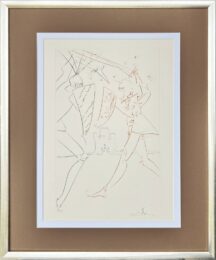

1904-1989
The prints of Salvador Dalí are rooted in a rich past. In actuality, Dalí’s prints have a history that dates back to his early years of art school. The young Dalí was taught the fine art of engraving and etching by his mentor. Dalí gained a respect for the technical details of printmaking, a respect he would maintain throughout the rest of his life. The connection between Dalí and graphic prints is in fact intricate and protracted. In his lifetime, Dalí produced just around 1,700 graphic prints. A large number of them are hand-signed, limited-edition editions. Some are regarded as some of the best prints created in the 20th century.
Dalí had the ability to experiment with a wide range of subjects through his print work, including etchings, engravings, mixed media, lithographs, and photo-litho. Dalí would produce beautiful suites or single prints. These suites frequently feature a book motif, with the prints acting as the artwork. Among the literary works Dal illustrated were Alice in Wonderland, Hamlet, and The Old Man and the Sea. Other times, similar suites would focus on different subjects, such as flowers (FlorDal), science fiction (Conquest of the Cosmos), or fine print production (Currier and Ives). Dal also produced single prints that showcased his flawless printmaking skills. Prints by Dalí that are among his best include Flower Man, Symphony Bicyclette, Dream Passage, and The Studio of Dalí.
Although it might be speculated that Dalí produced many more prints than the “approved” ones we attribute to him today, Dal’s first prints appeared in the 1920s. His superb craftsmanship is seen in works like Head of a Young Girl and Immaculate Conception. The graphic piece Les Chants de Maldoror is among Dal’s best-known creations. The stories that separate the suites are a perfect match for the pre-surrealistic aspects of the book. A complete set of this suite is now in high demand. The majority of these early works were etchings and engravings; as Dalí’s printing skills improved, he expanded the range of his mediums and themes.
The 1960s are often referred to as the “Golden Age” of Dalí’s prints. In fact, Dalí produced some of his most creative pieces during this decade. For an edition of The Divine Comedy, he finished one hundred wood block prints. This suite is regarded as a work of genius, and Dalí produced magnificent graphics to complement Virgil’s poetry. A fruitful collaboration with the American publishers Phyllis and Sidney Lucas also began throughout this decade. The Lucas’ and Dalí’s combined efforts would result in some of the most enduring Dal paintings ever. Prints like The Drawers of Memory, Fantastic Voyage, The Lucky Number of Salvador Daíi, The Studio of Dalí, and Departure of The Fishermen are examples of the prints that resulted from their collaboration. For Dalí, these were undoubtedly successful years. Over the course of this decade, Dal finished hundreds of photographs. His output was extraordinarily high. However, some of his best graphic creations remained to be seen.
Dal returned to his melting clocks painting, his most well-known creation, in the 1970s. Some people believe that Dalí’s 1975 lithograph Changes In Great Masterpieces is his best creation overall. The collection consists of six images, five of which are Dalí’s interpretations of paintings by Rembrandt, Vermeer, Raphael, and Velasquez. The Persistence of Memory, Dalí’s own masterwork, is reinterpreted in the sixth picture.
Together with his American publishers, Phyllis and Sidney Lucas, Mozart created this suite. Dalí updates his original piece by including a fourth melting clock. The broken clock creeps through the midst of the scene. The fourth clock, according to some, represents the fourth dimension, or time. Some people think that when Dal revised The Persistence of Memory, some 40 years after the original, he was considering his own transience and legacy and paying homage to the Dal of old.
Changes in Great Masterpieces was only one of Dalí’s outstanding creations during the 1970s. In the suites Moses and Monotheism, Imagination and Objects of the Future, and Alchemy of The Philosophers, he produced some magnificent artwork. His two four-piece “puzzles,” The Rejuvenation of Time and The Puzzle of Life, are his largest lithographs. Ten Recipes of Immortality, a collection of three dimensional “pop-up” prints, is an example of how he expanded the scope of his graphic works into the third dimension. Although the 1960s may have been Dalí’s most productive decade, the 1970s appear to have been his most inventive and creative years as he explored new concepts and pushed himself even farther.
In 1982, Dalí’s final prints were released. Dalí’s health had already started to deteriorate by this point, and his output had significantly decreased. However, Dalí was still able to create some excellent graphic prints despite his advanced age. Portrait of Autumn, which is bathed in gorgeous yellows, greens, and reds, is a glorification of the god Dionysus. Collectors of Dalí’s work see Chevalier Surealiste as a must-have piece, and it pays homage to one of Dalí’s heroes, Velasquez. Crucifixion is a superb example of Dalí’s artistry and a testament to his interest in Roman Catholicism.
Dalí spent his entire life working as a printmaker. When evaluating his legacy, one must take into account the graphic arts creations he developed. Some of Dalí’s most artistic icons and imagery, as well as some of his best uses of his imagination, can be seen in these prints.